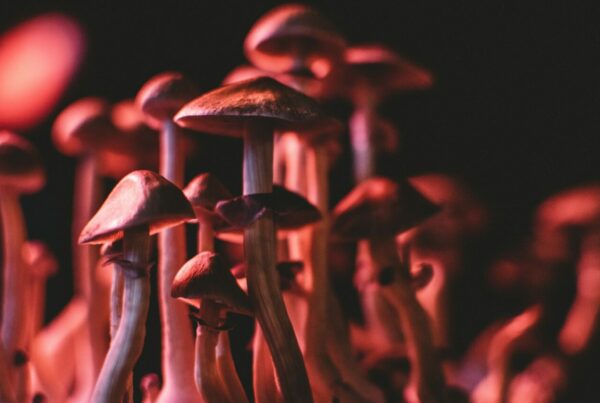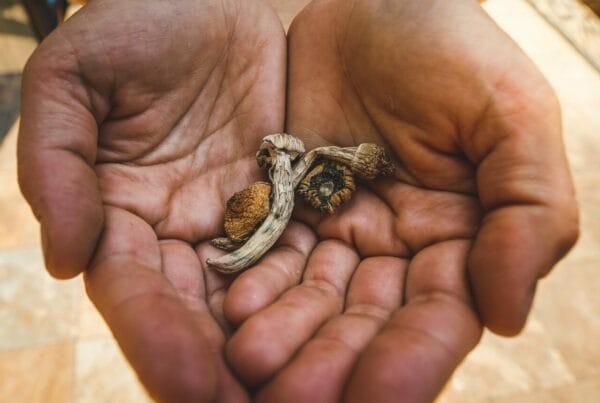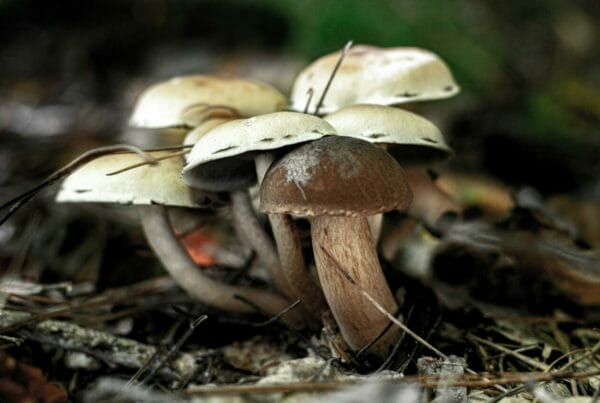Once thought of as merely a myth, the strength of Psilocybe mexicana is now gaining recognition thanks to the advancements in psilocybin research. The psychedelic research field is consistently uncovering its therapeutic potential, gradually gaining acceptance within the medical community. Experts in the field find this growth promising and continuously work towards determining safe dosage levels for medicinal purposes.
Key Takeaways
- Researchers are utilizing innovative methods like liquid chromatography and tandem mass spectrometry to measure the potency of mushrooms.
- Clinical trials are being conducted on Psilocybe Mexicana and other mushroom types to evaluate their potential therapeutic applications.
- Understanding the genetic diversity in magic mushrooms is crucial for creating an accurate dosage guide.
Psychedelic Mushrooms: From Unknown to Groundbreaking Research
In the past, only a few conditions were known to benefit from Psilocybe Cubensis. However, current research on psilocybin is revealing a wealth of previously hidden medicinal properties.
Psilocybe Mexicana and other potent strains are being explored by experts for clinical trials and in-depth research. Whether the studies are in vivo or in vitro, this strain is providing a true reflection of the benefits and effects of this fungus species.
Psychedelics Making Their Way into the Market
Previously shrouded in mystery, continuous breakthroughs and discoveries are now piquing public interest, especially for those in search of therapeutic alternatives. Traditional mental health treatments often prove inadequate, leading individuals to seek more effective options.
Welcome, magic mushrooms.
Patients struggling with mental health disorders are turning to psilocybin, having demonstrated effectiveness in treating depression, alcohol addiction, anxiety, compulsions, tics, chronic pain, and more.
Clinicians are currently exploring innovative methods to accurately determine the ideal dosage for safe patient administration. Notably, a group of researchers from the University of Texas has contrived a model to extract psilocybin and psilocin concentrations.
The potency of magic mushrooms can indeed be established clinically.
Distinctive Features of Mexicana
Golden Teachers, Blue Meanies, and B-Plus mushrooms have been thoroughly examined. However, for a comprehensive understanding of safe magic mushroom use, further exploration of other species is necessary.
The Mexicana species, known for its antiquity and lower potency that matches medical drug standards, has gained popularity in research circles.
Despite its lower potency compared to other species, the Mexicana strain can produce effects similar to mainstream strains. Consequently, as microdosing gains acceptance among patients, this strain is becoming a preferred choice.
It possesses consistent quantities of psilocybin and psilocin, akin to other strains. So, what sets it apart from the rest? Its significance in history and anthropology sheds light on this.
Delving Into a Vibrant “Mexican” Past
Traditionally, psilocybe mexicana sprouted naturally in moss. Indigenous communities revered these psilocybin mushrooms, often associating them with mystical and supernatural occurrences.
Let’s focus on Mexican mushrooms. These shrooms’ first recorded use dates back over 2000 years, by the indigenous people of North and Central America. The Aztecs, an ancient civilization, dubbed these mushrooms as the “food of the Gods,” or “teonanácatl” in their vernacular.
Were the Aztecs present today, they would vouch for the Mexicana’s transformative, emotionally profound, and mentally balancing effects—without comprehending these contemporary terms.
Despite different cultivation methodologies, the mushroom has retained its natural psilocybin levels, asserting its genuineness. This authenticity is a universally recognized standard highly valued by researchers and psychedelic research institutions.
Innovative Methods for Testing Psilocybin Content and Potency
A team of ten researchers from the University of Texas at Arlington and other institutions have devised a novel method for testing the potency of psychoactive compounds in mushrooms. This innovative approach merges liquid chromatography and tandem mass spectrometry.
Here are two revolutionary methods:
- Liquid chromatography is a technique that helps to separate and examine mixtures of chemicals. Here, it’s being used to isolate active chemicals in mushrooms. This process involves making a liquid sample pass through a column packed with a solid substance (the stationary phase). The different chemicals in the sample interact with the stationary and mobile phases in disparate ways, which results in them separating at different speeds while moving through the column.
- Spectrometry is a discipline that studies how matter interacts with electromagnetic radiation across a range of wavelengths. It helps identify and measure substances based on the unique wavelengths of light absorbed and scattered by molecules. This enables the determination of the electronic, vibrational, and rotational states of a given chemical.
This method was utilized on five strains of magic mushrooms. The scientists found that the average total levels of psilocybin and psilocin across these strains varied between 0.879 and 1.36. These concentrations were higher than many other strains, including Bull Run and Cambodian. The accuracy of the study was confirmed by comparing the results with those from other independent laboratories.
The agreement between the findings of the two laboratories further confirms the reliability of their testing method for accurately determining the potency of the mushrooms.
If confirmed by experts, this could add a new range of techniques to the existing methods of testing psychedelic strength, acting as an extra safety measure to avoid incorrect dosage determinations.
Expanding Research to Other Species
There are benefits to extending research to other species. It can improve our knowledge of the health advantages linked to different strains, and provide baseline data on the effects of less potent mushrooms.
Moreover, it can help educate individuals about the influence of different dosages on the psychedelic experience. By comparing Mexicans with more potent strains like Psilocybe Cubensis, researchers can understand how varying concentrations of active compounds can affect therapeutic outcomes.
For example, the Blue Meanies strain produces stronger hallucinogenic effects, which could be effective in managing conditions like depression. Conversely, less potent strains are more suitable for microdosing or subtle uses such as enhancing mood or improving focus.
Genetic Diversity Leads to Safer Treatments
It’s not widely understood that different cultivars or varieties each have distinctive genetic profiles and range in their potency, chemical composition, and effects. Acknowledging this diversity allows healthcare practitioners to select the most suitable type for specific medical applications and adjust the dosage to meet individual requirements, thereby reducing risks and maximizing benefits.
Take, for instance, Psilocybe Semilanceata (Liberty Caps) or Psilocybe cyanescens. These contain distinct alkaloid compositions that might be beneficial in addressing anxiety. On the other hand, other synthetically grown mushrooms might be better suited for managing substance addiction or compulsive behaviors. This diversity aids in crafting personalized treatments that are safer and more effective.
From this, it follows that the genetic diversity in psychedelic mushrooms, in conjunction with novel methods of potency evaluation and identification, is vital for devising safer medical interventions.
Enhanced Safety in Medical Use
Let’s ponder over the potential benefits of safer dosage practices.
- Decreased frequency of overdosing: Accurate dosing eliminates the risk of overdose. This also suggests the necessity for clearer product labels to avoid any confusion amongst consumers.
- Increased predictability: With more precise dosing, individuals can better predict potential effects or experiences they might encounter during their psychedelic journeys. This can reduce overwhelming sensations and anxiety, resulting in improved patient satisfaction.
- Uniform measurement: To some extent, accurate dosing can foster a standard measure, making it easier for individuals to refer to charts for potential effects.
Experience the Advantages of Precisely-Dosed Shrooms through Advanced Potency Tests | Buy Magic Mushrooms Online at Magic Mushroom Toronto Canada
If these two groundbreaking methods continue to be adopted, unexpected effects will no longer be a concern. Combine this with smart online shopping at Magic Mushroom Toronto Canada. We offer dried mushrooms that guarantee a tranquil, relaxing psychedelic experience without excessive psychoactivity. Buy psychedelics online in Canada through Magic Mushroom Toronto Canada.
Frequently Asked Questions
Is the Mexican Psilocybe Mexicana similar to the Big Are Big Mexicans and Psilocybe Cubensis the same?
No, Big Mexicans and Psilocybe Cubensis are distinct strains of mushrooms, so they shouldn’t be confused. Big Mexicans have a greater compound isolation, ranging from 0.5% to 1%, making them significantly more potent
The appearance of Psilocybe Semilanceata and Psilocybe Cubensis differs noticeably. The former often sports a bell-shaped cap, while the latter usually has a conical shape.
What’s the highest concentration in Mexican mushrooms?
The concentrations of psilocybin and psilocin in Mexican mushrooms can peak at 0.25%. Even though these levels match the relatively low concentrations found in the Golden Teacher strain, they can still induce profound psychedelic experiences, which might offer health benefits.
What’s the recommended safe dosage medically?
Usually, a dosage ranging from 1 to 2 grams is recommended. However, this quantity may vary depending on factors like the method of consumption, individual metabolic rate, and the specific potency of the strain. Some individuals opt for sub-threshold doses between 0.05 (50mg) and 0.025 grams (250mg) to mitigate the hallucinogenic effects.





